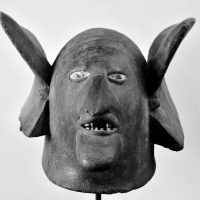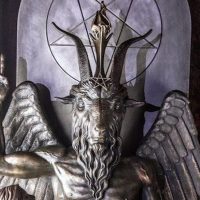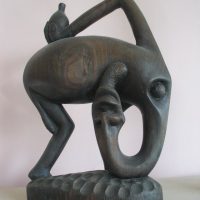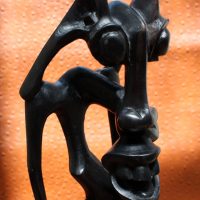Shetani : The Evil Spirits
Listen
At a glance
| Description | |
|---|---|
| Origin | East African Mythology |
| Classification | Spirits |
| Family Members | N/A |
| Region | Kenya. Tanzania. Mozambique |
| Associated With | Evil, Shapeshifting |
Shetani
Introduction
Shetani, a term prevalent in several East African nations, signifies the spirits of East African mythology and local folklore. Often depicted as malevolent entities, they manifest in diverse forms and possess varying abilities. Among these, the Makonde people from regions spanning Tanzania, Mozambique, and Kenya are renowned for their craftsmanship in creating Makonde Shetani sculptures and figurines. These representations of malevolent spirits hold significant cultural and spiritual significance, reflecting the deep-rooted beliefs within Swahili-speaking communities. Far from being mere figments of imagination, Shetani embody themes of darkness, adversity, and the perpetual conflict between forces of good and evil in the collective consciousness of these societies.
Physical Traits
Physically, the Shetani of various types manifest as distorted amalgamations of human and animal forms. They adopt a myriad of shapes including abstract, animalistic, anthropomorphic, and combinations thereof. Whether portrayed as one-legged, one-armed, cyclopic, or adorned with exaggerated orifices and appendages, the defining characteristic of Shetani remains their distorted and asymmetrical human-like figure. Carvings crafted from ebony or African blackwood often feature descriptions such as “one eye, a toothless, open mouth and a body which was bent over backwards with its head facing the wrong way”. These descriptions offer a glimpse into the unsettling appearances of Shetani, existing beyond the realm of human comprehension. While their true forms remain veiled in mystery, oral traditions and artistic representations provide insight into their eerie visages.
Frequently depicted as distorted humanoids, they exhibit asymmetrical traits like a single eye, elongated limbs, or contorted bodies twisted at unnatural angles. The addition of animalistic features such as horns, fangs, and claws further enhances their grotesque allure, symbolizing their primal and untamed essence. Makonde sculptures, renowned for their meticulous portrayal of Shetani, capture these unsettling characteristics in intricate detail, serving as poignant visual reminders of their malevolent presence and the need to guard against their influence.
Family
In the realm of Shetani, the notion of family takes on a unique twist, diverging from traditional familial structures. Instead, these malevolent beings are categorized into various classes, each embodying distinct characteristics and behaviors. Among them are the perilous Ukunduka, known to feed off human energy through sexual intercourse, and the chameleon Shetani, exhibiting carnivorous tendencies reminiscent of the lizard. Conversely, the benign medicinal Shuluwele is recognized for its role in gathering herbs for sorcerers. While the overarching term “Shetani” encompasses the essence of these malevolent entities, they are known by a plethora of names, each indicative of their specific attributes and powers.
For instance, the infamous Popobawa, hailing from Zanzibar, is notorious for its association with bat-like wings, violence, and the lingering scent of burnt sulfur. Ukunduka are reputed for their ability to siphon human energy during intimate encounters, while the shapeshifting Chamagu, akin to chameleons, possess insatiable appetites. Each name carries its own weight, serving as a chilling reminder of the diverse forms and dangers these spirits embody, highlighting the complexity and diversity within the realm of Shetani.
Other names
Shetani, a Swahili term prevalent across several East African nations, denotes primarily hostile indigenous Islamic spirits. Rooted in Arabic, the term “Shaitan” translates to devil or adversary, from which “Shetani” finds its origins. Synonymous with the English term “Satan,” which shares its Semitic linguistic roots, Shetani embodies a similar concept of malevolent entities within the cultural and religious contexts of East Africa.
Powers and Abilities
Shetani manifest in a multitude of forms, each imbued with distinct powers. Among these spirits is the notorious Popo Bawa, known for its terrifying reputation associated with violence, sodomy, and the stench of burnt sulfur. The Shetani wield a diverse array of abilities aimed at inflicting harm and instigating discord. They can possess individuals, compelling them to commit acts of violence and insanity. Manipulating natural forces, they unleash illness, misfortune, and anomalous phenomena. Their influence extends even to the realm of dreams, where they appear as menacing figures, disturbing sleep and instilling doubt and fear. Far from being passive entities, Shetani are active agents of chaos, ceaselessly exploiting human vulnerabilities and disrupting the natural order.
Modern Day Influence
Shetani maintain their revered status in East Africa, with sporadic reports of their sightings ebbing and flowing with the changing seasons. Renowned Makonde artist George Lilanga (1934–2005) achieved global acclaim through his striking sculptures and paintings depicting Shetani. Samaki Likankoa, a master carver from Tanzania, pioneered the iconic Shetani style in the early 1950s. While Samaki was the progenitor of the “shetani” aesthetic, its rapid proliferation led to its widespread adoption and commercial success in the markets of Dar es Salaam and Nairobi.
Despite occasional dismissals as mere superstition, Shetani continue to maintain relevance in the modern era. Within contemporary East African society, references to these spirits permeate everyday discourse, serving as both cautionary tales and explanations for misfortune. The fear of Shetani manifests in various forms, from avoidance of behaviors deemed risky to seeking protection through traditional healers and spiritual practices.
Related Images
Frequently Asked Questions
What is lorem Ipsum?
I am text block. Click edit button to change this text. Lorem ipsum dolor sit amet, consectetur adipiscing elit. Ut elit tellus, luctus nec ullamcorper mattis, pulvinar dapibus leo.
What is lorem Ipsum?
I am text block. Click edit button to change this text. Lorem ipsum dolor sit amet, consectetur adipiscing elit. Ut elit tellus, luctus nec ullamcorper mattis, pulvinar dapibus leo.
What is lorem Ipsum?
I am text block. Click edit button to change this text. Lorem ipsum dolor sit amet, consectetur adipiscing elit. Ut elit tellus, luctus nec ullamcorper mattis, pulvinar dapibus leo.
What is lorem Ipsum?
I am text block. Click edit button to change this text. Lorem ipsum dolor sit amet, consectetur adipiscing elit. Ut elit tellus, luctus nec ullamcorper mattis, pulvinar dapibus leo.
What is lorem Ipsum?
I am text block. Click edit button to change this text. Lorem ipsum dolor sit amet, consectetur adipiscing elit. Ut elit tellus, luctus nec ullamcorper mattis, pulvinar dapibus leo.







